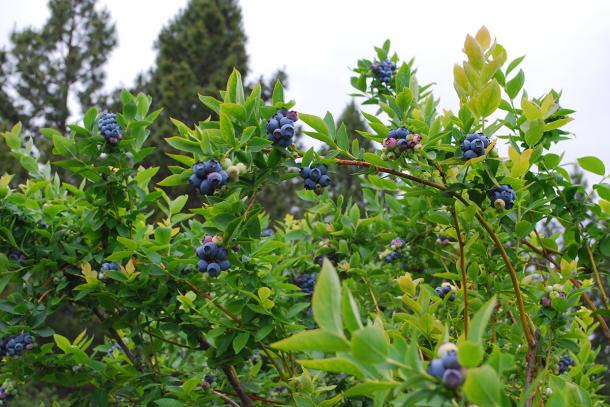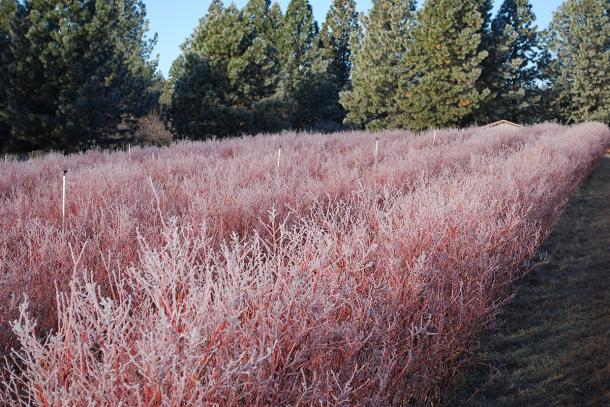Sierra Cascade: Farming Blueberries and the Wild
June 10, 2016
For most of the year, Sierra Cascade Blueberry Farm seems to run itself naturally amid a diverse ecosystem of native insects, birds, and other wildlife. Much of that is due to thoughtful planning, and for six weeks out of the year, the farm kicks into overdrive, with all hands on deck to bring 8.5 acres of blueberry crop to market.
John Carlon and his wife, Armen, started an organic blueberry farm in Forest Ranch at a time when the crop was untested in California. They’ve proved it can be done sustainably, selling at the Ferry Plaza and other farmer markets for more than 20 years. But farming is just one piece of what John does. Throughout the year, he runs the nonprofit River Partners, which tackles large-scale restoration projects that protect the environment and create wildlife habitat. He also finds time to serve on CUESA’s Board of Directors, bringing his nonprofit and agriculture expertise to initiatives such as CUESA’s Seller Pledge.
We spoke with John at the height of the harvest about what makes farming blueberries so unique, and how farmers and conservationists can work together in the service of our waterways, wildlife, and food system.
How did you get started farming organic blueberries?
We started the farm in 1988 with the idea of growing a crop organically. We weren’t sure if blueberries would make it in California because there weren’t many blueberry farms, and there was a lot of doubt that they would grow here. Blueberries take about four years to come into production once you plant the crop, so in the interim, I got a job with the Nature Conservancy. I got involved in restoring riparian habitat, the forest that grows along rivers and streams. It basically meant planting native trees in the floodplain. We bought flood-prone farmland, farmed it for a few years, and then restored it. I managed their agriculture program, and worked with ecologists and biologists every day.
How did that conservation work influence your approach to farming?
I remember driving up to my farm after work one day, after I’d be farming organically for several years. I realized that there was all this other stuff I needed to do to make my farm more sustainable. For the last 20 some years, our goal has really been to integrate our farm ecologically into the larger landscape. This has meant replacing off-farm inputs—things that you would bring onto the farm to produce your crop, such as water, fertilizers, pest control, energy, etc.—by working with the land to produce all of those services to grow the crop.
For example, we try to capture all of the rainfall and make sure we aren’t irrigating in excess of that water that’s naturally going to fall on our property over the course of the winter. Another example is pollination. We’ve replaced using the European honeybee, a non-native bee, with native bumblebees, which co-evolved with blueberries and are a better pollinator. They’re free and they’re already on my farm, and all I have to do is make them happy.

Tell us about your work at River Partners.
Another farmer and I started River Partners 18 years ago. Our mission is to restore habitat for the benefit of people and wildlife. It’s very similar to farming, except the crop we produce is native trees, shrubs, and grasses targeted to benefit wildlife. To date, the organization has planted over 2 million trees and native plants in about 13 different watersheds from San Diego to Redding.
Typically we’re buying properties that get damaged all the time by floods, and we repurpose that land from agriculture back into its native state, which is riparian forest. We’ll work with our neighbors, who are typically farmers, and hire them to do some of the fieldwork. We try to have a five- to seven-year transition. For example, if we buy a property that is growing silage for the dairy next door, and they’ve been doing that for 20 years, we don’t go to the dairy and tell them they’re out of silage. We say, “We’re going to transition this over a five-year period. We’re happy to keep working with you, but you need to start looking for a new supplier.” It gives everybody time to plan and adjust their business.
Agriculture and conservation can sometimes be seen as being at odds with one another. How does your work at River Partners bridge this?
I don’t see us in conflict at all. We’ve restored over 8,000 acres of habitat, all of those projects have neighbors that are farmers. We work with them in the planning stages to make sure that what we’re going to do with the property is not going to negatively impact their operation.
In the larger context, with the drought, every one of these pieces of property that we’ve worked on is irrigated crop land. All that water comes out of groundwater or rivers. Once we’ve done the restoration work and the native plants have been established, we can basically retire the irrigation pumps. We’re doing studies to look at how much water we’re retiring and repurposing so it can stay in the stream. On one ranch, we did a comprehensive analysis of the water we’re going to save when we stop irrigating, and that’s going to be about 7,000 acre feet of water a year. That’s a direct benefit to agriculture. At the end of the day, that’s a lot of water is either available for fish in the river or our neighbors who are continuing to farm.

Going back to Sierra Cascade, what’s something people may not know about blueberries?
There are two commercial fruit crops that are indigenous to North America that we eat: blueberries and cranberries. Blueberries evolved here. I think one of the reasons I’ve been able to farm without off-farm inputs, is that blueberries don’t have the same pest relationships that a lot of other crops have. Pollinators like bumblebees evolved with blueberries, so they’re geared to pollinate them. Working with North American fruit in North America is a lot easier than working with a fruit that was brought from some other place in the world.
Is that why you chose to farm blueberries?
It was total happenstance. We grew blueberries because nobody else was growing them at the time. They looked like they were hard to grow but easy to sell, and I thought I was a better farmer than marketer. You can have a commercial blueberry farm that is 10 acres, which is pretty small acreage, and we had a small piece of property. The farm is now 8.5 acres of blueberries, but the whole farm is 61 acres. We’re letting the rest of it go back into wildlands and habitat.

How do you balance being a farmer and running a nonprofit?
Do you want me to start crying? [laughs] During harvest time, it’s kind of crazy and not sustainable, but it’s just six weeks out of the year that are really brutal, and the rest of the year it’s fine. We don’t have a lot of active management on the farm; it’s set up so that it takes care of itself. I don’t want to make it sound too easy, but it’s not a lot of manipulation on our part. It’s more about getting it set up so that it fits in well with the landscape.
It’s inspiring for me to come every year to participate in the CUESA market. There are seriously some of the best farmers in the world, in terms of the quality of the produce and the way they grow food. There’s always a lot to learn from them, not just in terms of the agronomic practices or how to integrate your farm into the environment, but also social justice issues, food quality, and preservation of heritage varieties. It’s just a great convergence of all things agriculture.
Find Sierra Cascade Blueberry Farm at the Ferry Plaza Farms Market through June on Saturdays.
Farm photos from Sierra Cascade Blueberry Farm. Watch John Carlon talk about rewilding our rivers at TEDxChico:
Topics: Environment, Farmers, Organic
